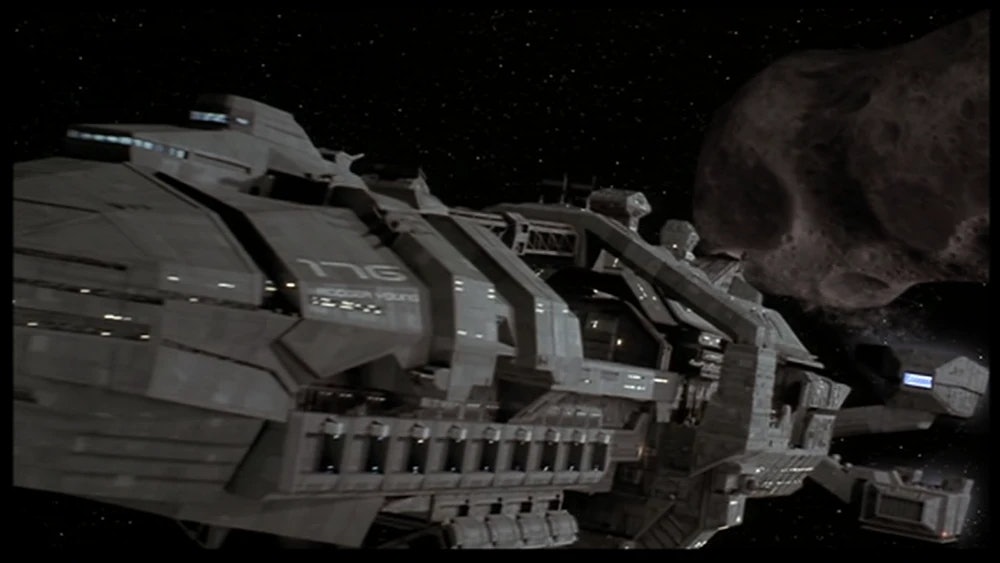
By the 23rd century, humankind hasn’t just discovered aliens — we’re at war with them. That’s the future presented in the 1997 film Starship Troopers, a militaristic satire that throws viewers into battle right from the start.
It’s humans versus giant, plasma-slinging bugs in an interstellar war with no end in sight. The bug’s home planet, called Klendathu, is located on the opposite side of the Milky Way, yet they still find a way to launch projectiles tens of thousands of light years away.

“Klendathu, source of the bug meteor attacks, orbits a twin star system whose brutal gravitational forces produce an unlimited supply of bug meteorites,” an unnamed voice announces during a military PSA within the first few minutes of the film.
While it’s never fully explained how the bugs manage to turn asteroids into projectiles, it’s clear that they present an existential threat to humanity. In one scene, a bug meteor destroys Buenos Aires, wiping the city clean off the map. And in another, starship captains have to dodge a sudden asteroid that spontaneously appears in their path, threatening to down the vessel.
Whatever the bugs are doing, they make it seem quite easy to wield asteroids as weapons. But in reality, moving rocks in space is a monumental task. Handily aiming and redirecting an asteroid to shove it off its orbit is a lot harder than Starship Troopers makes it seem, thanks to the laws of the universe — and the limitations of 21st-century technology.
Moving asteroids
The only time humanity ever successfully moved an asteroid was on September 26, 2022. NASA’s Double Asteroid Redirection Test (DART) took aim at the nearby asteroid Dimorphos in an attempt to alter its orbit.
Dimorphos orbits a larger asteroid, Didymos — neither of which pose an active threat to Earth. The DART test was just a test, designed to determine if it was possible to redirect an asteroid in the event that one does come hurtling toward our planet in the future.
Sure enough, the test worked. Scientists crashed a fast-moving, refrigerator-sized vehicle into Dimorphos, then watched to see its trajectory shift in the coming weeks. The asteroid’s orbit shortened from 11 days and 55 minutes to 11 days and 23 minutes.
That might not sound like much, but the DART test actually exceeded scientists’ expectations. If the only thing affecting Dimorphos’ orbit was the DART vehicle, it would have changed its orbit a minimum of seven minutes, Cristina Thomas, an associate professor of astronomy at Northern Arizona University, told Inverse earlier this year. Instead, multiple forces acted together to change the asteroid’s orbit by more than a half hour.
To be fair, humanity is only in the beginning stages of learning how to shake up an asteroid’s orbit — but the DART mission shows just how difficult it is to even make a slight change in trajectory.
Interstellar visitors
Asteroids are relatively small pieces of matter, and are typically bound by gravity to larger bodies such as the Sun, planets, or larger asteroids. That makes them difficult to disrupt, though collisions between asteroids and planets with enough force can send bits of rock flying on a new trajectory through space.
The vast majority of meteorites that land on Earth come from asteroids in the Asteroid Belt, which is located between Mars and Jupiter. And while asteroids, comets, and other cosmic objects can make their way into the Solar System from outside of it, those occurrences are considerably rarer.

If an asteroid came flying from the complete opposite side of the Milky Way and was able to travel by countless star systems without being roped into the gravity of any large bodies, then it could make it to Earth like the ones in Starship Troopers. But the bugs on Klendathu would have to launch a rock at least tens of thousands of years in advance in order to hit Earth during the time the film takes place.
The Milky Way is 100,000 light years across, and Klendathu appears to be on roughly the opposite edge of it from Earth (give or take 20,000 light years). Even if a bug asteroid was traveling at the speed of light, it’d take tens of thousands of years to get to our planet, which isn’t exactly the most effective strategy in time of war.
Perhaps there were wormholes or other shortcuts that the bugs used — though the film is scant on the details. But simply pushing on an asteroid wouldn’t necessarily turn it into a space projectile. At most, you might just give it a slight change in orbit.







